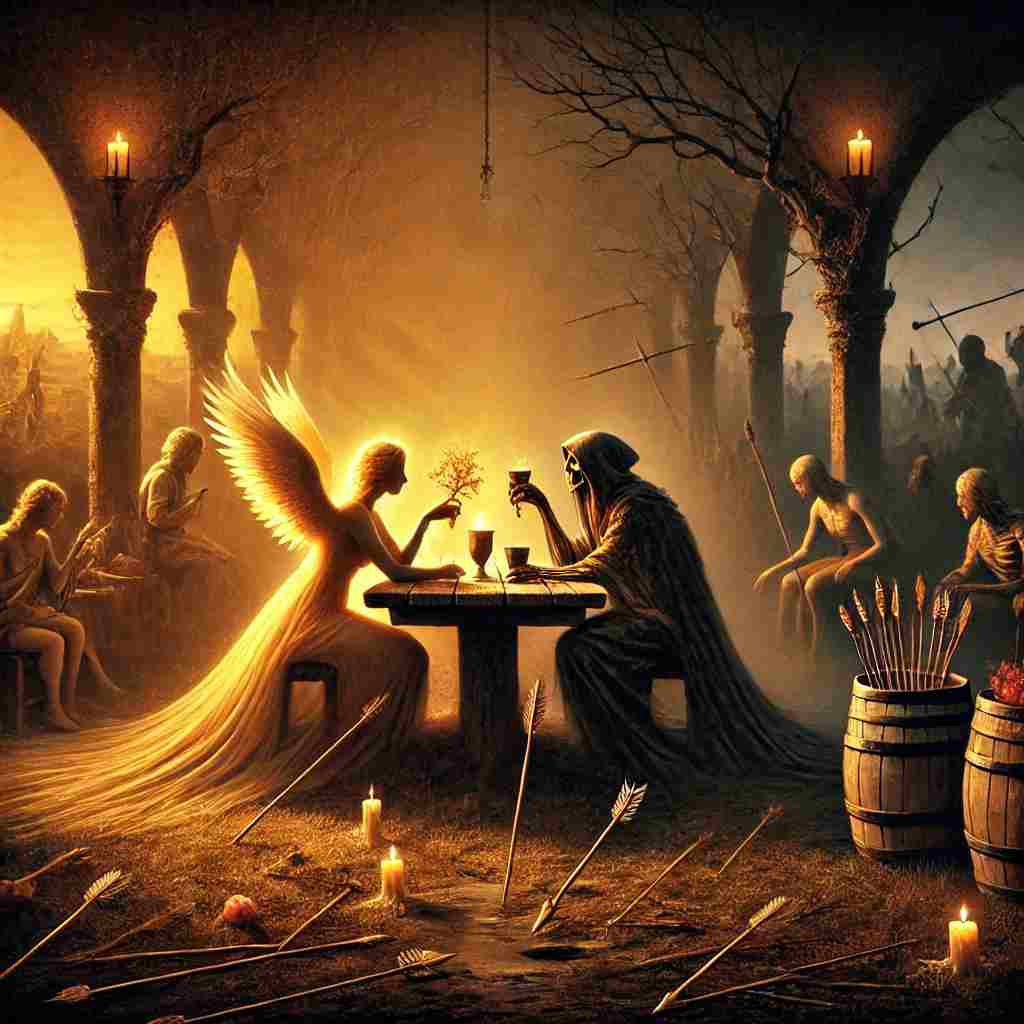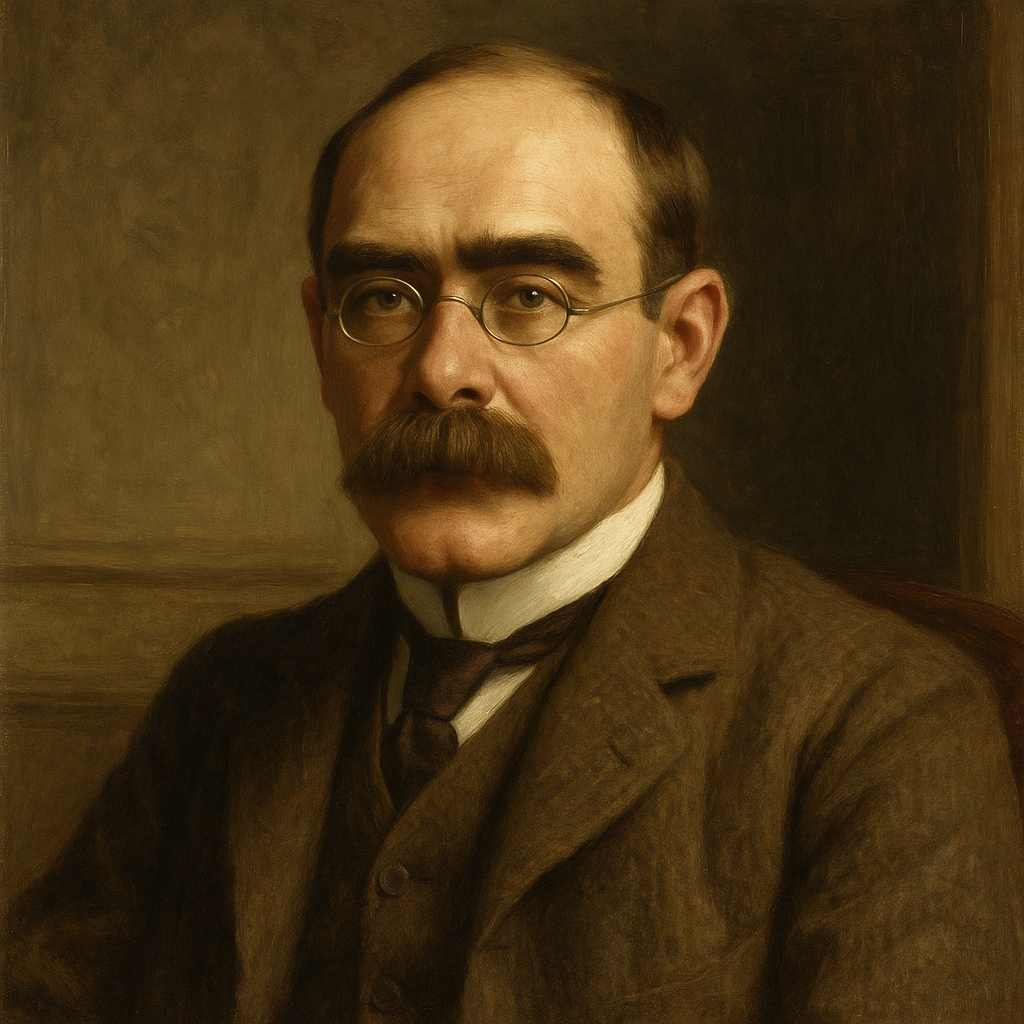The Explanation
Rudyard Kipling
1865 to 1936

Love and Death once ceased their strife
At the Tavern of Man's Life.
Called for wine, and threw — alas! —
Each his quiver on the grass.
When the bout was o'er they found
Mingled arrows strewed the ground.
Hastily they gathered then
Each the loves and lives of men.
Ah, the fateful dawn deceived!
Mingled arrows each one sheaved;
Death's dread armoury was stored
With the shafts he most abhorred;
Love's light quiver groaned beneath
Venom-headed darts of Death.
Thus it was they wrought our woe
At the Tavern long ago.
Tell me, do our masters know,
Loosing blindly as they fly,
Old men love while young men die?
Rudyard Kipling's The Explanation
Rudyard Kipling’s poem "The Explanation" offers a powerful allegory about the intertwined forces of Love and Death, casting them as beings whose actions inadvertently shape human lives and destinies. Through vivid imagery and metaphor, Kipling explores how love and mortality intersect in human experience, often with tragic results, leaving the reader with an ironic commentary on the blindness of fate.
Introduction: Love and Death as Allegorical Figures
In "The Explanation," Kipling personifies Love and Death, portraying them as figures who meet at the “Tavern of Man’s Life.” This setting—the tavern—serves as a metaphor for the transient nature of human existence. Taverns, often places of camaraderie and revelry but also impermanence, underscore the fleeting and fragile nature of life. Here, Love and Death momentarily cease their "strife," suggesting an eternal conflict between the two forces, as they throw their “quivers” onto the grass. A quiver, which holds arrows, symbolizes the influence each has on human life: Love’s arrows represent passion, attachment, and affection, while Death’s are associated with mortality and the end of existence. This opening scene sets the stage for a momentary lapse that leads to a tragic mingling of these powerful forces.
The Mixing of Arrows: A Symbol of Human Suffering
Kipling’s language emphasizes the gravity of the event, noting how, “When the bout was o’er they found / Mingled arrows strewed the ground.” This image of mixed arrows encapsulates the arbitrary and chaotic nature of human experience, as Love and Death inadvertently exchange arrows, each collecting some that do not belong to them. This confusion mirrors the unpredictability of life, where love and death seem to strike without discernible reason or pattern. The imagery of “mingled arrows” symbolizes how love can be tinged with the fear or presence of death, while death often shatters love, creating a deep sorrow in those who survive.
As the two figures hastily retrieve their arrows, Kipling emphasizes the “fateful dawn” that “deceived” them, suggesting that fate itself operates under a veil of mystery and error. The word “deceived” implies that even Love and Death are not omniscient or infallible; they too are subject to the same randomness that governs human life. This personification conveys Kipling’s critique of the randomness and inherent injustice within the natural order, which allows no clear rationale for why love should end so often in death, or why the young should die while the old continue to live.
Love’s Burden and Death’s Unwanted Task
The next lines describe the tragic aftermath: “Death’s dread armoury was stored / With the shafts he most abhorred; / Love’s light quiver groaned beneath / Venom-headed darts of Death.” Here, Death ends up with arrows meant to foster life and connection, while Love is burdened with “venom-headed darts,” arrows that bring only separation and grief. These lines evoke the bitterness and irony that result when love and death, as forces, intersect with unforeseen consequences. Death is left “abhorring” the arrows of love, suggesting that even Death is uneasy with the loss of innocence and vitality that it brings. Meanwhile, Love’s “light quiver” becomes a metaphor for its usual lightness and joy, now laden with the deadly potential that death imparts.
In these lines, Kipling may be commenting on the painful irony of human relationships, where love is often shadowed by loss and separation. Even as love brings people together, it carries the inherent possibility of ending, often prematurely, in death. This concept echoes throughout literature, where love’s beauty is often made more poignant and tragic by its impermanence. The metaphor of Love’s quiver “groaning” also highlights the burden and weight that loss places upon affection and attachment, giving the poem an elegiac tone.
The Final Couplet: A Meditation on Human Suffering
The closing lines bring the poem’s meditation on love and death into sharp focus: “Tell me, do our masters know, / Loosing blindly as they fly, / Old men love while young men die?” This rhetorical question invites readers to reflect on the apparent indifference or blindness of fate—or “our masters”—to the injustices that characterize life and death. The phrase “loosing blindly as they fly” conjures an image of arrows being shot haphazardly, without care or purpose, by the figures of Love and Death. This reinforces the randomness and cruelty of fate, which allows old men to continue loving, even as young men die, disrupting natural and expected life cycles.
The line “Old men love while young men die” underscores the reversal of natural order, where age and youth are often disconnected from love and death’s proper sequences. In a world governed by such indifferent forces, love is seldom without pain, and life’s continuation is riddled with the unexpected. Kipling’s choice to end the poem with this observation leaves the reader with a sense of resignation and sorrow, capturing the dissonance between the human yearning for justice and order and the harsh randomness of reality.
Conclusion
In "The Explanation," Kipling weaves an intricate allegory of love and death, suggesting that their forces, however powerful, are blind to the consequences they impart upon human lives. By describing the arbitrary mingling of Love’s and Death’s arrows, Kipling critiques the seeming unfairness and disarray that mark human experience. Through the imagery of “mingled arrows,” “venom-headed darts,” and a final, haunting question, he exposes the tragic and random intersection of love and mortality that defines human suffering. This poem, with its succinct yet potent lines, ultimately calls into question the fairness of fate, while acknowledging that love and death are often bound inextricably together, creating an inescapable cycle of joy and grief in the tapestry of human life.
This text was generated by AI and is for reference only. Learn more
Want to join the discussion? Reopen or create a unique username to comment. No personal details required!



Comments
No comments yet. Be the first to comment!